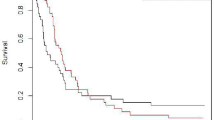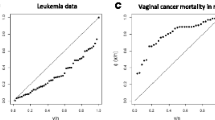Abstract
We propose a new extended regression model based on the logarithm of the generalized odd log-logistic Weibull distribution with four systematic components for the analysis of survival data. This regression model can be very useful and could give more realistic fits than other special regression models. We obtain the maximum likelihood estimates of the model parameters for censored data and address influence diagnostics and residual analysis. We prove empirically the importance of the proposed regression by means of a real data set (survival times of the captive snakes) from a study carried out at the Herpetology Laboratory of the Butantan Institute in São Paulo, Brazil.












Similar content being viewed by others
References
Atkinson AC (1985) Plots, transformations, and regression: an introduction to graphical methods of diagnostic regression analysis. Clarendon Press, Oxford
Buuren SV, Fredriks M (2001) Worm plot: a simple diagnostic device for modelling growth reference curves. Stat Med 20:1259–1277
Cancho VG, Bolfarine H, Achcar JA (1999) A Bayesian analysis for the exponentiated-Weibull distribution. J Appl Stat Sci 8:227–242
Cordeiro GM, Alizadeh M, Ozel G, Hosseini B, Ortega EMM, Altun E (2017) The generalized odd log-logistic family of distributions: properties, regression models and applications. J Stat Comput Simul 87:908–932
da Cruz JN, Ortega EMM, Cordeiro GM (2016) The log-odd log-logistic Weibull regression model: modelling, estimation, influence diagnostics and residual analysis. J Stat Comput Simul 86:1516–1538
Dunn PK, Smyth GK (1997) Randomized quantile residuals. J Comput Graph Stat 5:236–244
Gleaton JU, Lynch JD (2006) Properties of generalized log-logistic families of lifetime distributions. J Probab Stat Sci 4:51–64
Gupta RC, Gupta RD (2007) Proportional reversed hazard rate model and its applications. J Stat Plan Inference 137:3525–3536
Hashimoto EM, Ortega EMM, Cancho VG, Cordeiro GM (2010) The log-exponentiated Weibull regression model for interval-censored data. Comput Stat Data Anal 54:1017–1035
Lawless JF (2003) Statistical models and methods for lifetime data. Wiley, New York
Mendes GF, Stuginski DR, Loibel SMC, Morais-Zani K, Rocha MMT, Fernandes W, Sant’Anna SS, Grego KF (2019) Factors that can influence the survival rates of coral snakes (Micrurus corallinus) for antivenom production. J Anim Sci 97:972–980
Mudholkar GS, Srivastava DK, Friemer M (1995) The exponentiated Weibull family: a reanalysis of the bus-motor-failure data. Technometrics 37:436–445
Ortega EMM, Lemonte AJ, Cordeiro GM, Cancho GV, Mialhe FL (2017) Heteroscedastic log-exponentiated Weibull regression model. J Appl Stat 45:384–408
Prataviera F, Ortega EMM, Cordeiro GM, Pescim RR, Verssani BAW (2018) A new generalized odd log-logistic flexible Weibull regression model with applications in repairable systems. Reliab Eng Syst Saf 176:13–26
Prudnikov AP, Brychkov YA, Marichev OI (1986) Integrals and Series, volumes 1, 2 and 3. Gordon and Breach Science Publishers, Amsterdam
Rigby RA, Stasinopoulos DM (2005) Generalized additive models for location, scale and shape. Appl Stat 54:507–554 (with discussion)
Voudouris V, Gilchrist R, Rigby R, Sedgwick J, Stasinopoulos D (2012) Modelling skewness and kurtosis with the BCPE density in GAMLSS. J Appl Stat 39:1279–1293
Author information
Authors and Affiliations
Corresponding author
Additional information
Handling Editor: Bryan F. J. Manly.
Rights and permissions
About this article
Cite this article
Prataviera, F., Loibel, S.M.C., Grego, K.F. et al. Modelling non-proportional hazard for survival data with different systematic components. Environ Ecol Stat 27, 467–489 (2020). https://doi.org/10.1007/s10651-020-00453-5
Received:
Revised:
Published:
Issue Date:
DOI: https://doi.org/10.1007/s10651-020-00453-5




